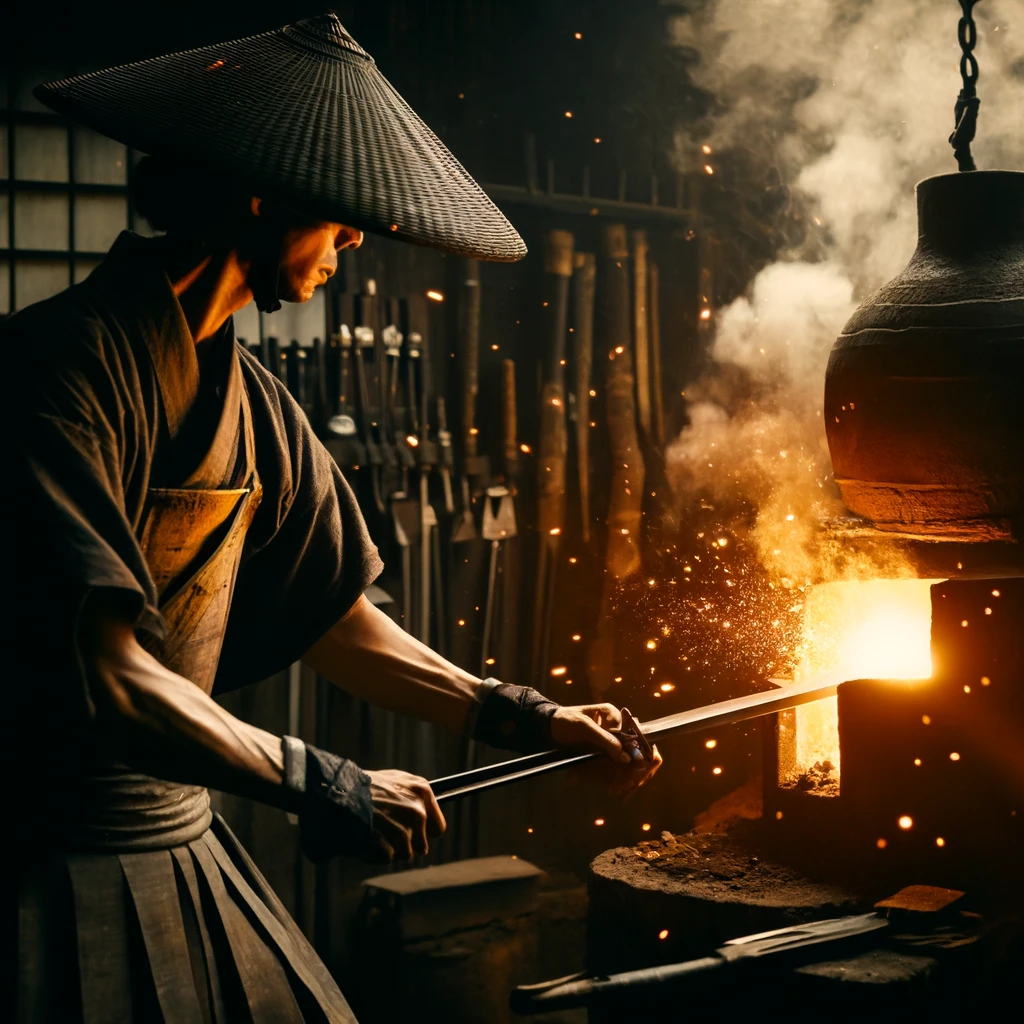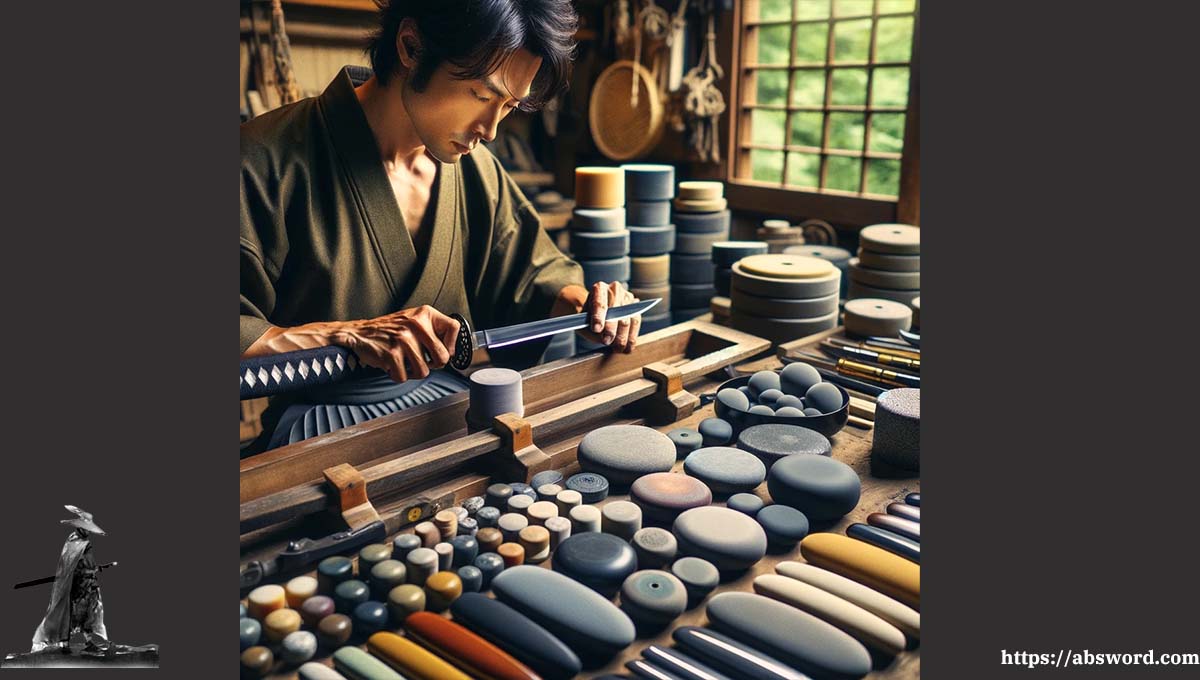Introduction
The Japanese sword, known as the katana, holds a revered place in Japan’s history and culture. These swords are not just weapons but are seen as artistic masterpieces and symbols of the samurai spirit. The art of making a katana, Japanese swordsmithing, is a meticulous process that combines unique materials and age-old techniques, resulting in blades known worldwide for their beauty and sharpness.

Historical Background
The art of sword making in Japan traces back over a thousand years, with significant influences from China and Korea. The techniques evolved remarkably during different periods in Japanese history. The Heian period (794-1185) saw the emergence of the curved tachi, precursor to the katana, which was further refined into its distinctive style during the Kamakura period (1185-1333). This era is considered the “Golden Age” of sword making, producing some of the most famous swordsmiths, such as Masamune and Muramasa, whose legendary blades are celebrated for their superior craftsmanship.
During the Edo period (1603-1868), as the country was at peace, swordsmiths focused more on the artistic aspects of blade making, which led to the diversification of styles and techniques. This period also solidified the cultural status of the katana among the samurai class, symbolizing their authority and honor.
Materials and Preparation
The traditional Japanese sword is crafted from a special type of steel called tamahagane, made from iron sand and charcoal in a clay furnace known as a tatara. The smelting process, which lasts three days and nights, involves the swordsmith carefully controlling the temperature to produce steel with varying carbon concentrations. This steel is then broken into smaller pieces, sorted by carbon content, and prepared for forging.

Forging Techniques
The forging of a Japanese sword is a labor-intensive process that requires great precision and skill. The swordsmith starts by stacking pieces of steel with different carbon contents and repeatedly heating, hammering, and folding them. This folding process, which can be repeated up to sixteen times, purifies the steel and creates layers that strengthen the blade and give it its distinctive pattern.
Once the basic blade shape is formed, the smith applies a layer of clay slurry to the blade in a precise pattern, which affects the blade’s hardness during quenching. The edge of the blade has a thinner coating to allow it to cool faster and become harder, while the spine, with a thicker coating, cools more slowly, allowing it to remain relatively softer and more flexible, providing the blade with a balance of sharpness and durability.
This section introduces you to the core of Japanese sword making, from historical roots to the sophisticated forging processes. In the following sections, we will explore blade polishing, cultural significance, and the modern state of swordsmithing. Stay tuned as we delve deeper into the artistic and cultural journey of the Japanese katana.
Blade Polishing and Sharpening
After the blade has been forged and tempered, it undergoes a critical transformation through polishing, which not only enhances the appearance but also the functional properties of the katana. This stage is as crucial as the forging itself, involving multiple types of polishing stones, each serving a specific purpose in enhancing the blade’s sharpness and aesthetic.
The polishing process starts with coarse stones, which remove the scale and imperfections from forging. This is followed by a series of finer stones, which refine the blade’s surface and gradually bring out the unique patterns created by the folding and forging process. The final stages use the finest stones to achieve a mirror-like finish, highlighting the blade’s beautiful temper line (hamon) and the distinct, wavy pattern (hada).
Sharpening the edge is the final step, requiring immense skill to maintain the correct angle and pressure to produce a razor-sharp edge. This meticulous process can take several weeks, reflecting the blade’s quality and the polisher’s mastery.
Cultural Significance
The katana is more than just a weapon; it is a symbol of the samurai’s soul and a testament to their dedication and skill. Throughout history, these swords have played a significant role in Bushido, the samurai code of conduct, embodying the virtues of loyalty, honor, and courage. Sword making is also intertwined with Shinto beliefs, where the swordsmith’s workshop is considered a sacred space, and the forging process a ritual that imbues the blade with a spirit (kami).
In modern times, the katana continues to be a powerful symbol of Japanese culture and craftsmanship. It appears prominently in films, literature, and martial arts, celebrated not only in Japan but also globally, showcasing the enduring appeal of these masterful creations.
Contemporary Swordsmithing
Despite the decline in practical use, the art of sword making continues to thrive in Japan, upheld by a new generation of swordsmiths who are as dedicated to their craft as their ancient predecessors. These artisans blend traditional techniques with modern technology to meet the demands of both collectors and practitioners of Iaido and Kenjutsu, ensuring the survival and relevance of this ancient craft.
Modern swordsmiths face numerous challenges, including the scarcity of traditional materials and stringent government regulations. Nevertheless, they persist, driven by a deep respect for their cultural heritage and a commitment to preserving these ancient techniques.
Japanese swordsmithing is an art form that has stood the test of time, evolving over centuries but always retaining its core principles of beauty, precision, and effectiveness. The katana is not merely a relic of the past but a continuing legacy that encapsulates the pinnacle of Japanese craftsmanship and cultural identity. Through the dedication of contemporary swordsmiths, the spirit of the samurai lives on in each blade that is forged, polished, and cherished.
This journey through the history, technique, and art of Japanese sword making reveals a multifaceted tradition that remains as sharp and enduring as the blades it produces.

